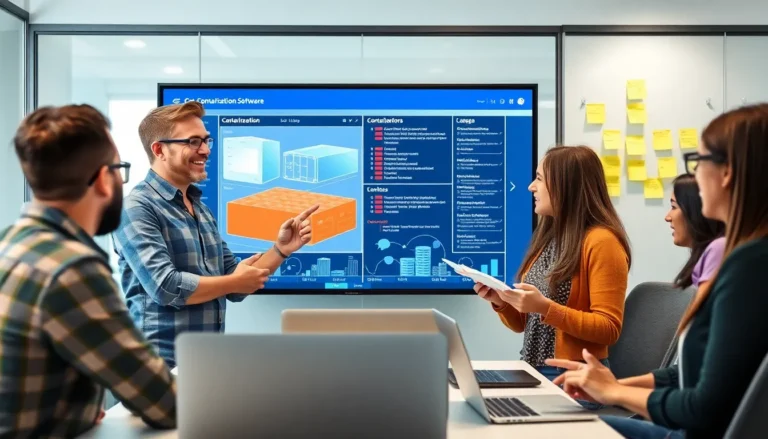In the fast-paced world of software development, where speed often trumps safety, it’s easy to feel like a tightrope walker juggling flaming swords. Enter Safe DevOps, the superhero of the tech realm, swooping in to save the day. By integrating security practices into the DevOps pipeline, teams can build and deploy software faster without sacrificing safety.
Imagine developing code that not only works like a charm but also keeps pesky vulnerabilities at bay. It’s like having your cake and eating it too—without the risk of a sugar crash. Safe DevOps isn’t just a buzzword; it’s a game-changer that empowers teams to innovate confidently. So buckle up and get ready to explore how to create a secure environment that lets creativity flourish while keeping the cyber villains at bay.
Table of Contents
ToggleUnderstanding Safe DevOps
Safe DevOps integrates security into every phase of the development lifecycle, ensuring software delivery remains quick without sacrificing safety. Embracing this method transforms traditional operations, allowing teams to innovate securely.
Definition of Safe DevOps
Safe DevOps represents a cultural shift that merges development and operations with a focus on embedding security practices throughout the process. This approach encourages collaboration among developers, security professionals, and operations teams, creating a proactive security mindset. By prioritizing security in every stage, organizations reduce vulnerabilities significantly, allowing for rapid deployment of applications without compromising the integrity of their systems.
Importance of Safe DevOps
Prioritizing Safe DevOps leads to enhanced security and compliance, ultimately protecting user data. Rapid deployment cycles benefit from built-in security measures, which mitigate risks associated with software flaws. Organizations adopting Safe DevOps experience fewer breaches and incidents, driving down costs related to security fixes. Encouraging a culture of shared responsibility fosters stronger communication and collaboration among teams, transforming security into a collective initiative. The result is a robust framework that meets regulatory requirements while supporting ongoing innovation.
Key Principles of Safe DevOps

Safe DevOps relies on key principles that enable organizations to integrate security into their development processes seamlessly.
Collaboration Between Teams
Collaboration fosters a unified approach to security. Developers, operations, and security professionals share insights throughout the software development lifecycle. This teamwork enhances communication and helps identify vulnerabilities early. Engaging all stakeholders promotes a security-first mindset. Regularly scheduled meetings and collaborative tools support this initiative, ensuring everyone is on the same page. As a result, organizations can address security concerns proactively. A cohesive team effort leads to swift resolution of issues, reducing the risk of security flaws in deployed applications.
Continuous Feedback and Improvement
Continuous feedback drives ongoing enhancement of security practices. Teams gather insights from each cycle, identifying areas for improvement. Automating security assessments provides immediate feedback, allowing teams to adapt quickly. Implementing changes based on this feedback strengthens overall security posture. Regularly scheduled retrospectives enable teams to reflect on past experiences and integrate lessons learned. By embracing a culture of continuous improvement, organizations can fine-tune their security measures efficiently. This approach not only minimizes vulnerabilities but also cultivates an environment that values sustained security innovation.
Implementing Safe DevOps Practices
Implementing Safe DevOps practices involves establishing comprehensive strategies that secure every phase of development. Organizations must prioritize effective risk assessment procedures and automated security testing to enhance overall security.
Risk Assessment Procedures
Risk assessment procedures play a critical role in identifying vulnerabilities within the development lifecycle. Teams should conduct regular assessments to pinpoint potential threats. Utilizing tools like threat modeling can effectively visualize attack vectors. Engaging in periodic audits ensures that teams stay informed about emerging risks. Additionally, collaboration between developers and security professionals fosters a proactive approach to risk management. Documented findings support continuous improvement, allowing organizations to adapt swiftly to new insights. Cumulatively, these practices lay a strong foundation for a secure development environment.
Automated Security Testing
Automated security testing streamlines the integration of security into the DevOps pipeline. Organizations can implement automated tools that regularly scan code for vulnerabilities. These tools not only expedite the testing process but also enhance accuracy and consistency. Continuous integration systems should include security checks at every stage. Real-time feedback enables developers to address issues promptly, minimizing the risk of delays in deployment. Teams can leverage reporting features to track security issues over time effectively. Overall, automated security testing cultivates a culture of security awareness and efficiency.
Tools and Technologies for Safe DevOps
Safe DevOps relies on various tools and technologies to integrate security effectively into the development process. Organizations leverage these resources to enhance security while maintaining efficiency.
CI/CD Tools
Continuous Integration and Continuous Deployment (CI/CD) tools form the backbone of Safe DevOps. These tools automate the software development pipeline, allowing teams to merge code changes frequently and deploy applications consistently. Popular CI/CD tools like Jenkins, GitLab, and CircleCI facilitate integration with security practices. By incorporating automated testing and security checks into the CI/CD process, vulnerabilities can be identified and addressed early in development. This approach enables teams to respond quickly to security issues without slowing down deployment cycles.
Security Scanning Tools
Security scanning tools bolster Safe DevOps by identifying vulnerabilities throughout the development lifecycle. Tools such as Snyk, Veracode, and Aqua Security provide automated scanning of code, containers, and infrastructure. Employing these tools allows teams to detect security flaws in real time, ensuring timely fixes. Regular integration of security scanning into the workflow enhances overall security posture and supports compliance with regulations. By using these proactive measures, organizations minimize risks and foster a culture of continuous improvement in security practices.
Safe DevOps represents a crucial evolution in software development practices. By embedding security into every phase of the development lifecycle, organizations can strike a balance between rapid deployment and robust protection. This cultural shift not only fosters collaboration among teams but also empowers them to proactively address vulnerabilities before they escalate.
Implementing Safe DevOps principles ensures that security becomes a shared responsibility rather than an afterthought. As organizations adopt automated tools and continuous feedback mechanisms, they cultivate an environment that prioritizes security innovation. Ultimately, Safe DevOps paves the way for safer software delivery while enhancing compliance and protecting user data.



